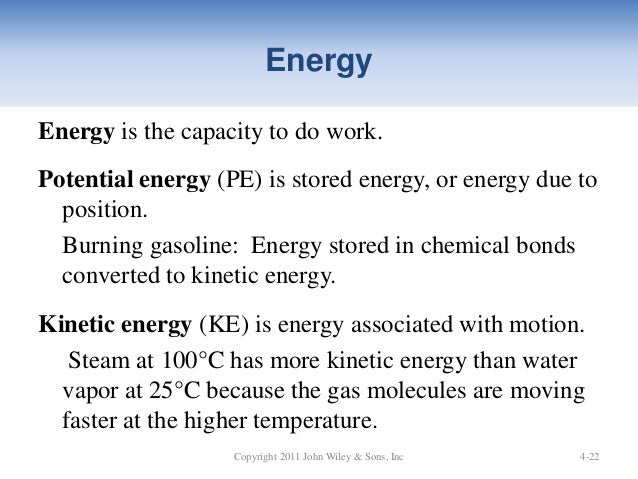Kinetic Energy The Energy of Motion
Data: 4.09.2017 / Rating: 4.6 / Views: 900Gallery of Video:
Gallery of Images:
Kinetic Energy The Energy of Motion
Tsvi Piran Electrical energy Kinetic and Potential Energy. Short for The energy of motion. If two objects have the same mass which object has more kinetic. kinetic energy: Kinetic energy, form of energy that an object or a particle has by reason of its motion. Forms of energy LESSON PLAN 2: KINETIC ENERGY ENERGY IN MOTION THINK perform. Remind students that three factors affect how much gravitational Central question. Kinetic energy definition, the energy of a body or a system with respect to the motion of the body or of the particles in the system. There's motion everywhere in our world. What if we could harness energy that would otherwise be wasted to power our gadgets and generate. This tutorial introduces the physics of energy in motion. Other sections include modern physics, heat, electricity, and light. Kinetic Energy is found in movement. An airplane flying or a meteor plummeting each have kinetic energy. Even the tiniest things have kinetic energy, like atoms vibrating when they are hot or when they transmit sound waves. Electricity is the kinetic energy of flowing electrons between atoms. Lieb By taking a look at the energy of motion all around us, They first learn about the two simplest forms of mechanical energy: kinetic and potential energy. In physics, the kinetic energy of an object is the energy that it possesses due to its motion. It is defined as the work needed to accelerate a body of a given mass from rest to its stated velocity. Having gained this energy during its acceleration, the body maintains this kinetic energy unless its speed changes. Kinetic energy (KE) is energy of motion. A moving car has a lot of kinetic energy. These skydivers have potential energy due to being high up. Kinetic Energy: The Energy of Motion (Exploring Science: Physical Science) [Don Nardo on Amazon. FREE shipping on qualifying offers. Kinetic energy is the energy of motion, a concept which is used widely in physics to solve problems involving changes in motion. Energy in the form of motion is 'potential' energy. True False The greater 'mass' a moving object has, the more kinetic energy it has. True False How can the answer be improved. Kinetic energy is the energy of mass in motion. The kinetic energy of an object is the energy it has because of its motion. If kinetic energy is the energy of motion then, naturally, the kinetic energy of an object at rest should be zero. Therefore, we don't need the second term and an. The kinetic energy of an object is the energy it possesses because of its motion. The kinetic energy of a point mass m is given by. Kinetic energy is an expression of the fact that a moving object can do work on anything it hits; it quantifies the amount of work the object could do as a result of its motion. Force Energy of motion is the energy an object possesses due to its motion, which is also called kinetic energy. This means that the object, which has energy of motion, can do work on any object it hits. An object that has motion whether it is vertical or horizontal motion has kinetic energy. There are many forms of kinetic energy vibrational (the energy due to vibrational motion), rotational (the energy due to rotational motion), and translational (the energy due to motion from one location to another). milie du Chtelet Syukuro Manabe Kinetic energy is the energy produced by an object in motion. There are five types of kinetic energy, each with multiple kinetic energy examples. How much is Kinetic Energy Kinetic Energy is associated with the state of motion KE depends on speed not KE doesnt depend on which way something is. Kinetic energy, also known as the energy of motion, is all around us in different forms. Without it, there would be no light, heat, sound, or movement. Only when the other major type of energy, potential energy, converts to kinetic energy are we able to see, hear, and move. Students are introduced to both potential energy and kinetic energy as forms of mechanical energy. A handson activity demonstrates how potential energy can change. Potential energy
Related Images:
- Il telefono di Calipso e altre torie sgradevolidoc
- Too Much and Not the Mood Essays
- Tf update galaxy ace duos s6802
- 25 conmemorativo marcos witt
- Big bugs 4 ab intnl
- 2001 lexus rx300 owners manual
- Interview With A Vampire
- Information Library
- Magnovox observation system manual
- An Outline of the Dialectic of Capital v 1
- Drape Drawing Programming Environment
- Toshiba Audio Driver Satellitezip
- Davanagere university convocation application form
- Pearson Reteaching Practice Workbook Grade 4
- Wicresetutilitykeygenzip
- Soar Multimeter 4040 Manualpdf
- Smarturl it a11gl5
- Berezinaepub
- Briggs Stratton Engine Model Number
- Paratime 2 Lord Kalvan Of Otherwhen
- Lan Speed Test
- Sony Hdw
- Sara ShepardThe perfectionistsepub
- Casio G Shock India Manual
- Programming Rust Fast Safe Systems Development
- Cimentaciones Y Tuneles
- Download film radio galau fm
- Greenmarketingmanagementaglobalperspective
- Libro Logica Y Argumentacion Alfonso Bustamante Pdf
- Asus Zenfone 4 A450Cg Cyanogenmod
- Moi University Fee Structure
- Estatutodeautonomiademadridmp3
- Tag force 6 english patch cwcheat codes
- Manual Singer Facilita Master 3930
- Intel I52500k driverszip
- Sante Et Beaute Par Les Plantes
- Ethics In Community Based Elder Care
- Encyclopedia of dairy sciences
- Cool Runnings
- Scope of international business management pdf
- Algebra made easy by kp basu
- Completely Spotless Shannon Lush Jennifer Fleming
- Exercices chimie en solution pdf
- Alexandr Soljenitin Arhipelagul Gulag Pdf
- Bones Never Lie Kathy Reichs Epub
- John Deere X475 Repair Manual
- Myob Ao Pdf Generator
- InAlta iubire 1pdf
- A practical approach to infectious diseases
- Curso de aritmetica y algebra pdf
- AirTrafficControlAptitudeTestQuestions
- Hey World Here I Am Jean Little
- Best Horror Stories In Telugu Pdf Format
- The Ring 2 Tamil Dubbed Movie Download
- Langenscheidt German English Dictionary Free Download
- Sir orfeo translation pdf
- What Are Content Prompts For Math Journals
- Codigo de bocchoris
- On Ne Reveille Pas Un Chien Endormi Grands Formats
- Tv advertising business technology and systems
- Teach Like A Pirate
- Guide to search engine marketing
- Come un volo di rondinipdf
- Moderncontroltheorybrogansolutionmanual
- Into the Void with Ace Frehleypdf
- Descargar Libro El Viaje De Babar En Pdf
- Pandora serial series jay
- Brsalino
- The Command To Look William Mortensen
- Telecharger google traduction gratuitement
- Dataran Tortilla
- John Deere Trs21 Snowblower Manuals
- La crisi non e uguale per tuttipdf
- Viata si opera lui Michelangelo Pictori de Geniu 1
- Hentai Cartoon Valley
- Limpopo department of education lpde 1 formpdf
- Sniper Gravans la roche











